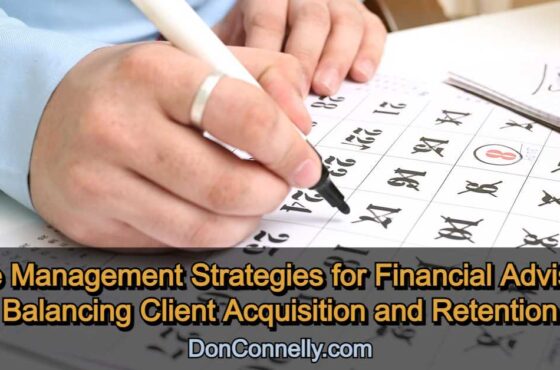3 Strategies Advisors Are Using to Break Through Stagnation to Get to the Next Level
 “I feel my team and I have reached a stage of stagnation. How can we build on what we have and continue to grow the business?”
“I feel my team and I have reached a stage of stagnation. How can we build on what we have and continue to grow the business?”
That sentiment is becoming a common theme among many of the advisors who enroll in our workshops and training programs. I can also attest that it is pervasive throughout industry, which means it happens to most every advisor or advisor team. Regardless of what stage you’re in, you can do all the right things to move through that stage and then realize that what got you to that point isn’t enough to get you to the next level. So, you stagnate. And you know that in this business, if you’re not deliberately moving forward, you’re actually falling behind.
I’ve written in the past about advisors who fall into the complacency trap, where advisors cling to familiar habits and patterns in their comfort zone. It’s more comfortable to do the things they’ve always done even though it dooms them to getting the same results.
The only way to break through stagnation to get to the next level is by taking some risks and stepping outside your comfort zone. Take the same advice you give your clients that without risk there are no returns. Here are three strategies successful advisors are using to boost productivity and grow their business.
#1. Specialize and go niche
Many advisors, especially those in the early stages of growth, attempt to cast as wide a net as possible to gather their leads. But that can be a highly inefficient way to prospect because, in essence, it’s just a numbers game. The more successful advisors have learned that, by casting a more narrow and targeted net, they can gain efficiencies, while focusing on prospects who match their idea of an ideal client. They have also found that, by developing a unique expertise and using it to burrow deeply into a niche, it is much easier to differentiate themselves because there’s little if any competition.
Practically speaking, deep-niche marketing allows you to focus your time, energy, and resources, enabling you to streamline all your processes to creating a superior client experience for one type of client. That makes you highly referable.
The challenge for many financial advisors, most of whom start out as generalists, is it takes time to develop the relevant knowledge to be able to carve out a niche and make it productive enough to sustain them. You could get lucky and strike a highly productive vein early on, but you should expect it to take some time. nevertheless, there’s no time like the present to get started.
#2. Expand your capacity with an associate Advisor
Every financial advisor reaches a critical juncture in the growth stage where they crash into a capacity wall—the point when there just isn’t enough time to do what needs to be done to grow your business. You might already be employing technology to create more efficiencies but there still comes a point when finding new clients gives way to the necessities of back-office work, plan preparation, and client service.
One solution is to clone yourself. Find a person who shares your characteristics and enthusiasm for helping people achieve their financial goals and then download your years of experience and knowledge to make that person your associate advisor.
To be sure, it does require an investment of time and resources to find and develop the right person, but the return on investment can be significant.
#3. Consider the hybrid Advisor model
Unquestionably, the rise of robo-advice has been a disruptive force that is transforming the wealth management industry. While the debate surrounding the efficacy of robo-advice continues, its appeal continues to grow, especially among younger, emerging investors, who are skeptical of traditional financial advice.
The good news is, according to a Wells Fargo/Gallup survey, nearly three-quarters of investors still want access to human advisors, but they also want access to digital advice. However, less than a quarter of investors want their money managed exclusively by human advisors. In another survey, Accenture found that 68 percent of emerging wealthy and high net worth investors now prefer hybrid advice models over traditional models. The bottom line for financial advisors who fail to embrace these trends and the automated technology driving them is they will likely be fishing from a shrinking pool of assets.
As a result, an increasing number of advisors are transitioning to the hybrid advisor model, which seeks to combine the best aspects of a traditional, advisor-driven offering with the efficiency and accessibility of automated digital platforms to offer a more flexible approach for investors who want more control in how they access and manage their finances.
The automated technology of digital platforms allows advisors to shift their focus to financial planning and other value-added services to strengthen client relationships and grow their clientele. More importantly, the hybrid model increases advisors’ scalability, enabling them to serve a growing clientele at a high-quality level.
Digital capabilities can also enhance advisors’ value proposition by improving communication and offering on-demand access to portfolio performance. With increased connectivity comes more frequent client interactions which are key to strengthening relationships and building trust.
Watch this 3-minute video to learn how our workshop ‘Become the Obvious Choice’ can help you and your team overcome the stagnation stage and get to the next level!
See workshop details and enroll today!
Open only a few times a year, this workshop is also available on demand, online or on site, for entire teams. Call 941.346.1166 or fill in this form to get in touch and further discuss.



